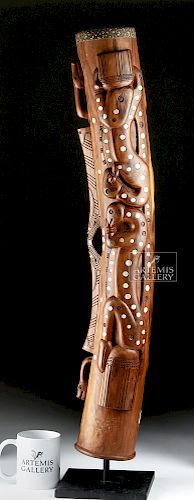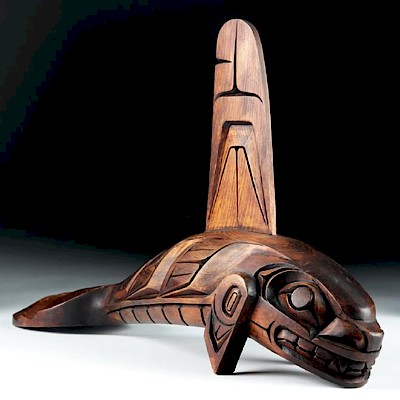Beautiful 20th C. Trobriand Islands Wood Hand Drum
Lot 39e
About Seller
Artemis Gallery
686 S Taylor Ave, Ste 106
Louisville, CO 80027
United States
Selling antiquities, ancient and ethnographic art online since 1993, Artemis Gallery specializes in Classical Antiquities (Egyptian, Greek, Roman, Near Eastern), Asian, Pre-Columbian, African / Tribal / Oceanographic art. Our extensive inventory includes pottery, stone, metal, wood, glass and textil...Read more
Categories
Estimate:
$950 - $1,400
Absentee vs Live bid
Two ways to bid:
- Leave a max absentee bid and the platform will bid on your behalf up to your maximum bid during the live auction.
- Bid live during the auction and your bids will be submitted real-time to the auctioneer.
Bid Increments
| Price | Bid Increment |
|---|---|
| $0 | $25 |
| $300 | $50 |
| $1,000 | $100 |
| $2,000 | $250 |
| $5,000 | $500 |
| $10,000 | $1,000 |
| $20,000 | $2,500 |
| $50,000 | $5,000 |
| $100,000 | $10,000 |
| $200,000 | $20,000 |
About Auction
By Artemis Gallery
May 24, 2018
Set Reminder
2018-05-24 10:00:00
2018-05-24 10:00:00
America/New_York
Bidsquare
Bidsquare : Northwest Coast, Tribal, & Pre-Columbian Art
https://www.bidsquare.com/auctions/artemis-gallery/northwest-coast-tribal-pre-columbian-art-3238
Featuring Pacific Northwest Coast Native American Art from respected collector / dealer, Joseph Alphabet. Artemis Gallery info@artemisgallery.com
Featuring Pacific Northwest Coast Native American Art from respected collector / dealer, Joseph Alphabet. Artemis Gallery info@artemisgallery.com
- Lot Description
Oceania, Papua New Guinea, Milne Bay Province, Trobriand Islands (sometimes Kiriwina Islands), Massim people, ca. 20th century CE. A beautiful wooden drum, known as a kundu, with a long, gently curved body and a handle carved integrally to one side. The top has lizard skin stretched across it. Carved in relief along the sides are zoomorphic figures - lizards and snakes, but with zoomorphic elements like hands pressed to their faces or into their mouths. Dozens of abalone shell discs are inlaid into the bodies of the animals, who also form the handle, which features serpentine heads at either end. Size: 4.5" W x 31" H (11.4 cm x 78.7 cm); 33.25" H (84.5 cm) on included custom stand.
These drums are made throughout Papua New Guinea, from a variety of local woods, and come in many forms - some dramatically carved like this one, others painted bright colors, and they are made through a complex process of hand-carving and burning that has been repeated for centuries. When in use, blobs of wax, honey, or coal tar are sometimes put onto the skin to alter the drum's sound.
See a very similar-shaped drum at the National Gallery of Victoria, Melbourne, Australia (ETH26-1973).
Provenance: private Newport Beach, California, USA collection
All items legal to buy/sell under U.S. Statute covering cultural patrimony Code 2600, CHAPTER 14, and are guaranteed to be as described or your money back.
A Certificate of Authenticity will accompany all winning bids.
We ship worldwide and handle all shipping in-house for your convenience.
#133673Small area of water staining around the bottom. Roughly 80% of the abalone shells are still present.Condition
- Shipping Info
-
All shipping is handled in-house for your convenience. Your invoice from Artemis Gallery will include shipping calculation instructions. If in doubt, please inquire BEFORE bidding for estimated shipping costs for individual items.
-
- Buyer's Premium



 EUR
EUR CAD
CAD AUD
AUD GBP
GBP MXN
MXN HKD
HKD CNY
CNY MYR
MYR SEK
SEK SGD
SGD CHF
CHF THB
THB
















